Frogs in Ohio – with Photos
This post contains links to affiliate websites, such as Amazon, and we receive an affiliate commission for any purchases made by you using these links.
Ohio is home to at least 15 species of frogs and toads. If you are looking for ways to help identify Frogs in Ohio, this is a simple guide to help you spot which frog is which, with photos.
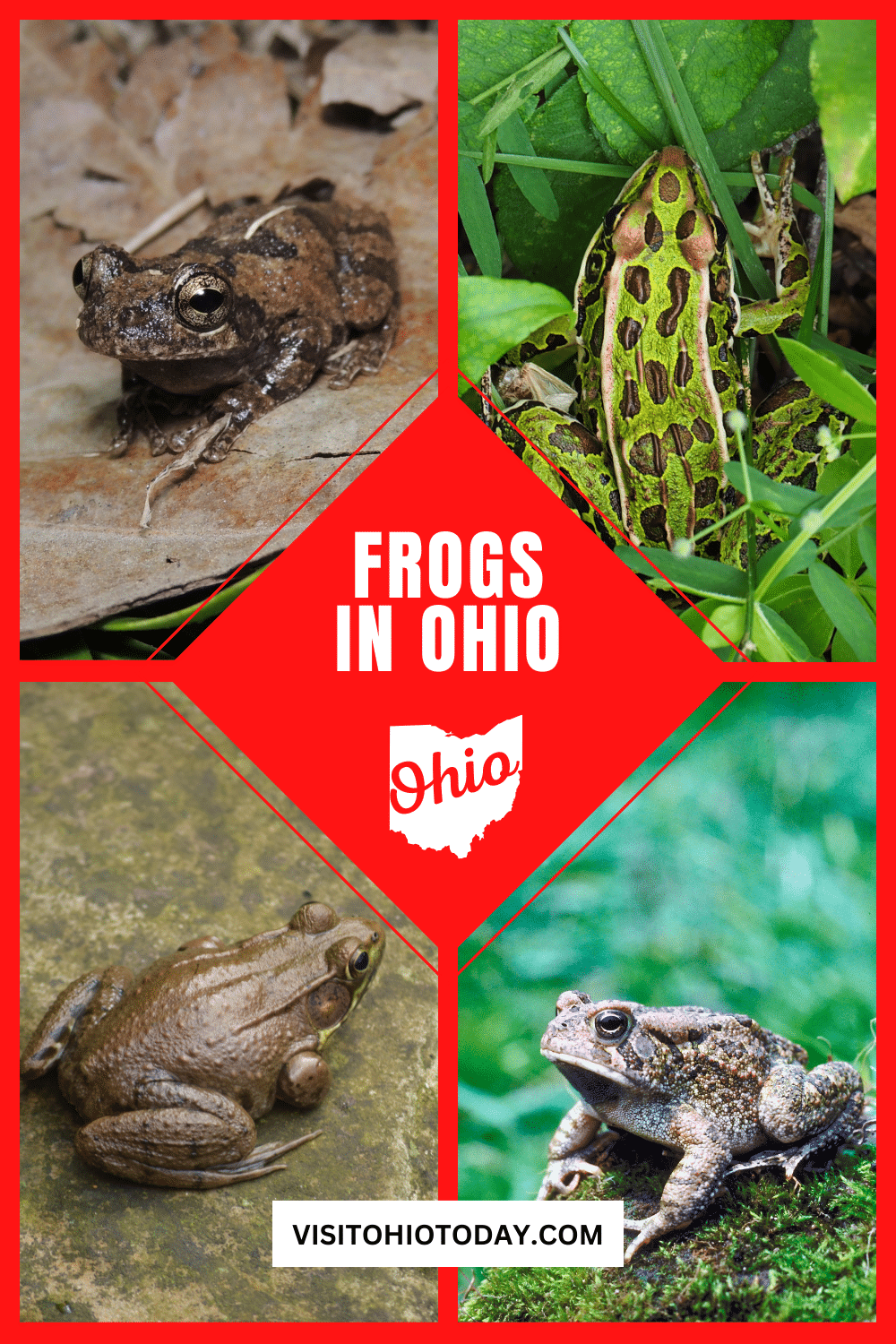
About Frogs in Ohio
Frogs have moist, quite smooth skin and they leap. Toads have dry, warty skin and they hop. Each species of frog and toad comes in a variety of colors and with various markings, making them difficult to identify in some cases.
Cindy’s Insider Ohio Tips
It’s a lot of fun trying to identify any frogs and toads I see when I’m out hiking. I have come across quite a few of the featured frogs in this article. The best time to spot them is between January and May.
Frogs and Toads in Ohio
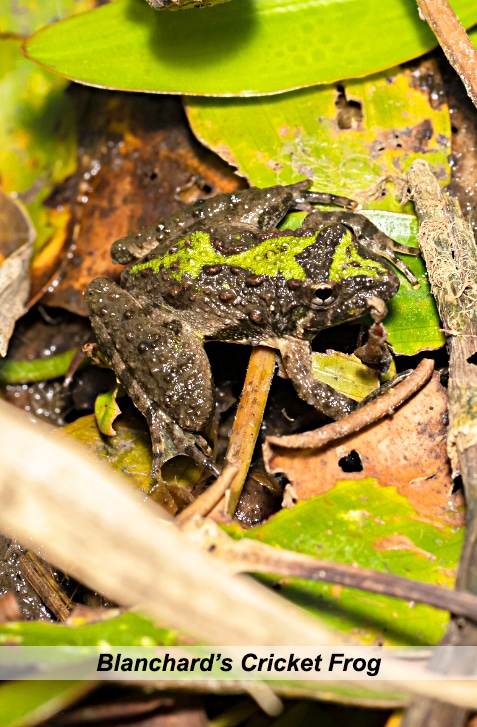
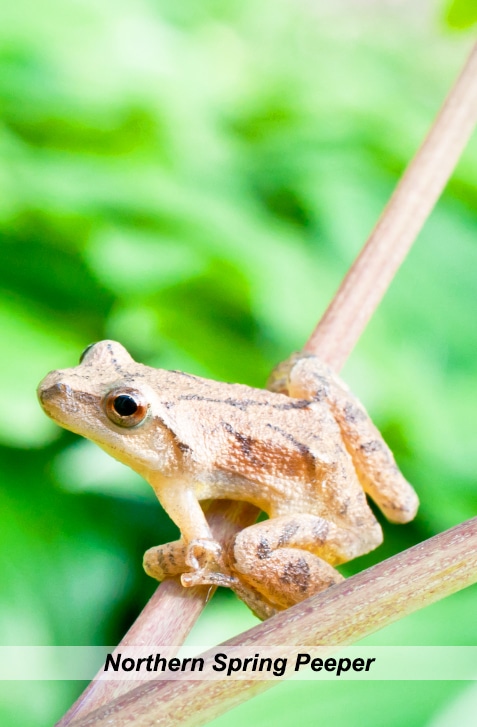
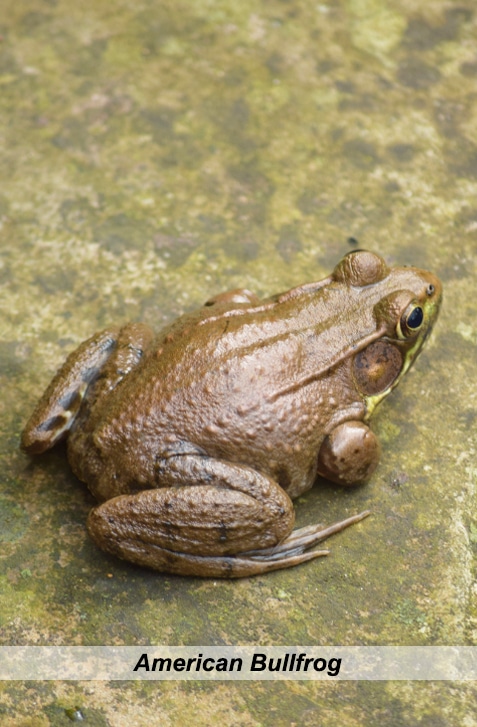
Blanchard’s Cricket Frog
Acris crepitans blanchardi | ½ to 1½ inches long
The Blanchard’s Cricket Frog is brown, gray, or olive with some red or green markings on the back of some individuals. There is a dark triangle between the eyes and a jagged dark line on the back of each thigh.
- Habitat: Open, sunny areas by rivers, creeks, and ponds.
- Distribution and status: The Blanchard’s Cricket Frog is found in the western two-thirds of Ohio. The species is declining rapidly in northern Ohio, but there are no apparent declines in the south.
Northern Spring Peeper
Pseudacris crucifer | ¾ to 1¼ inches long
The Northern Spring Peeper has combinations of yellow, brown, tan, reddish, and olive. The best identifier is the dark X on its back. For tiny frogs, they have a very loud, shrill call.
- Habitat: Swamps and moist woodlands, staying on the ground in thickets and under dead leaves or rotting logs.
- Distribution and status: Found throughout Ohio. Numbers are low to non-existent in west Ohio apart from the southwest. Massive congregations have not been seen in western Ohio, but occur regularly in the east, especially in the southeastern counties.
American Bullfrog
Rana catesbeiana | 3½ to 6 inches long
The American Bullfrog is usually a shade of green or brown with occasional dark spots on the back. The skin is smooth and slimy. The deep call of the bullfrog can be heard up to a mile away.
- Habitat: Bullfrogs will inhabit any permanent body of water.
- Distribution and status: Bullfrogs are found throughout Ohio. The abundance of this species could be partially responsible for the decline of other species.
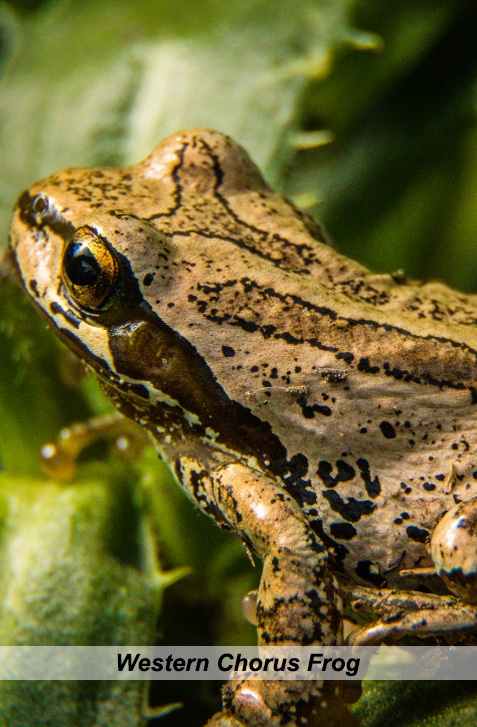
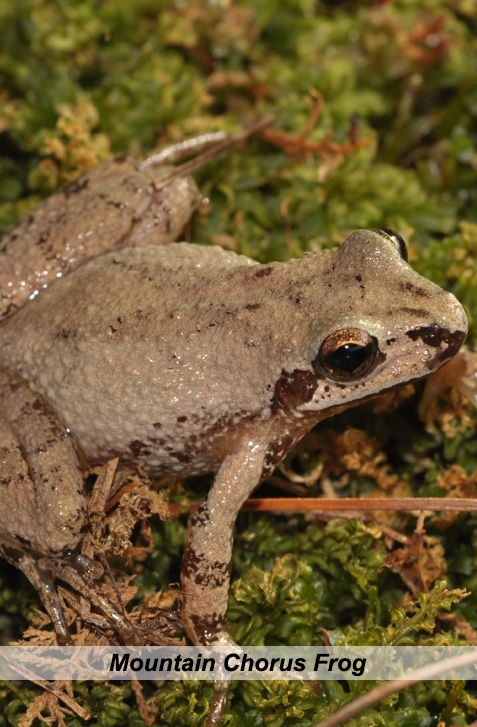
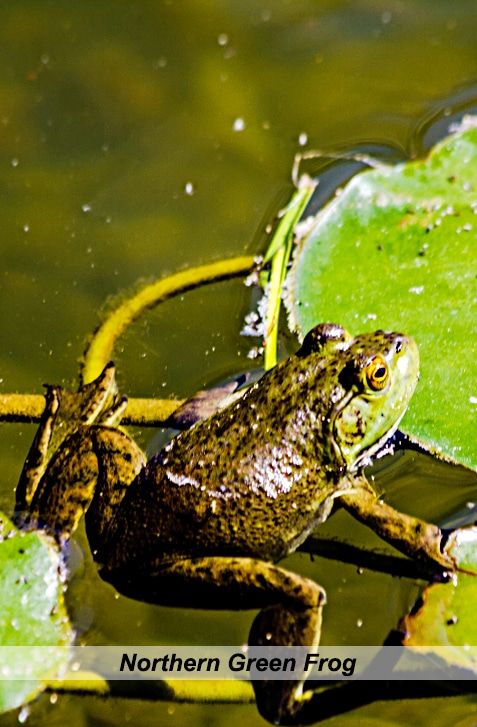
Western Chorus Frog
Pseudacris triseriata | ¾ to 1½ inches long
The Western Chorus Frog is brown, gray, olive, or tan. There are three dark stripes on the back which may be broken into spots. A thick dark line runs from the snout, through the eye and down the back.
- Habitat: Wherever dense thickets are available, such as marshes, swamps, and fields
- Distribution and status: Found in most counties of Ohio, a little less likely in the southeast. This species is normally found in large numbers.
Mountain Chorus Frog
Pseudacris brachyphona | 1 to 1¼ inches long
This frog has smooth skin that can vary from olive to light brown. Two curved stripes extend from the shoulder to the groin, but these stripes can be so faint they are almost impossible to see.
- Habitat: Moist, wooded hillsides around springs and seeps
- Distribution and status: This species is only found in the west and southwest of Ohio. In the regions where they are present, they are common.
Northern Green Frog
Rana clamitans melanota | 2¼ to 3½ inches long
These frogs are green or brownish-green. There are dorsolateral folds (they look like raised lines) from behind the eye to about halfway down the back.
- Habitat: Found in most aquatic environments
- Distribution and status: Found throughout the state. The Green Frog is one of the most common species in Ohio, found in almost every county and township.
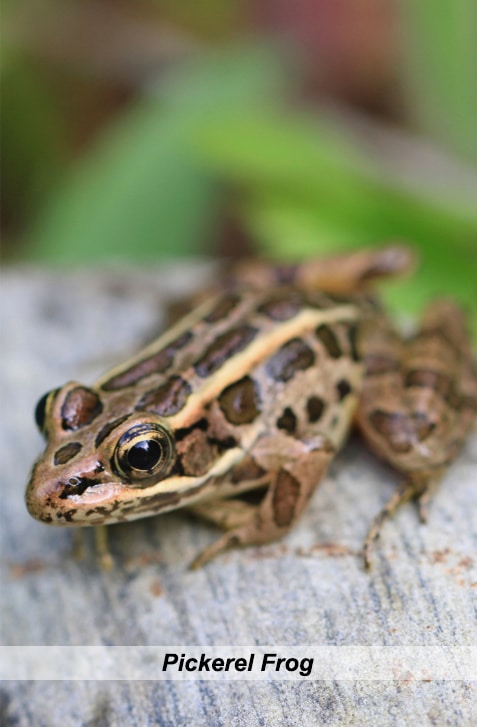
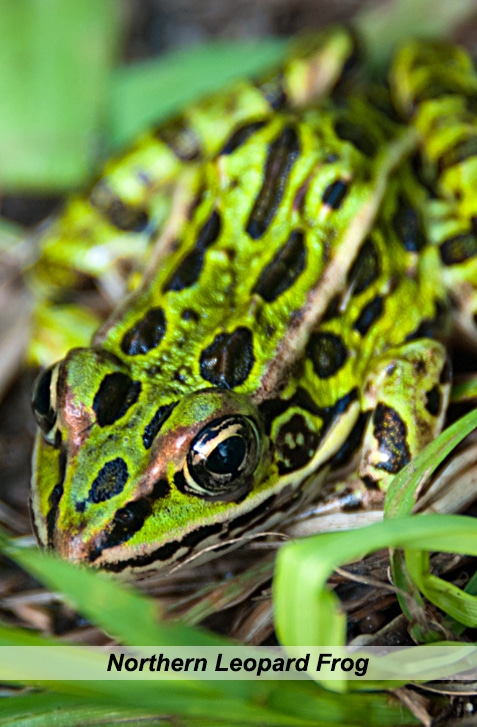
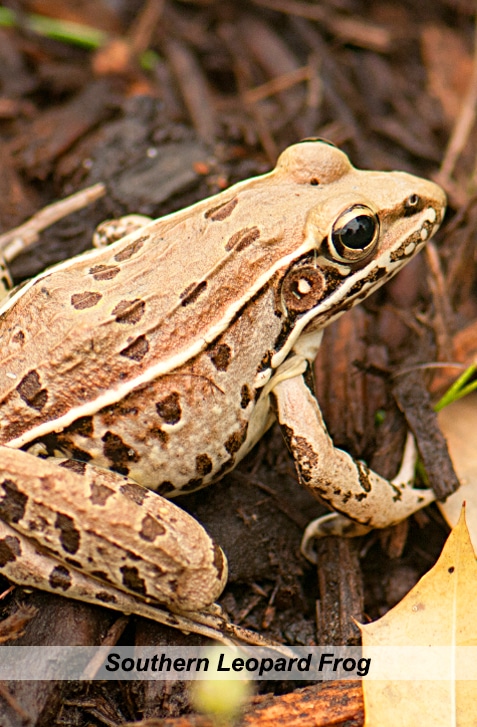
Pickerel Frog
Rana palustris | 1¾ to 3 inches long
The Pickerel Frog may be tan, light brown, or olive. Two rows of dark square spots run down the back of the frog. These frogs are quite distinctive from any others.
- Habitat: Streams, springs and seeps, fens, and wet meadows
- Distribution and status: These frogs are mainly in the eastern half of the state, although they are present in some western counties. This frog is reported as common where it is present.
Northern Leopard Frog
Rana pipiens | 2 to 3½ inches long
The Northern Leopard frog is green, brown or tan. The belly is always white. Two dorsolateral folds run from behind the eye along the back. Quite large black spots are present on the back, face and legs.
- Habitat: Wet meadows, streams, and lakes as well as agricultural areas.
- Distribution and status: Found throughout Ohio. The Northern Leopard Frog is abundant, but numbers are declining in the southeastern counties.
Southern Leopard Frog
Rana sphenocephala utricularius | 2 to 3½ inches long
The Southern Leopard Frog is green or brown. Two or three rows of random black spots are present on the back.
- Habitat: Meadows, pastures, and wooded areas.
- Distribution and status: This frog is only present in two counties in the south of Ohio, Scioto and Lawrence. A breeding population has never been found in Ohio. It is thought that they cross the river from Kentucky.
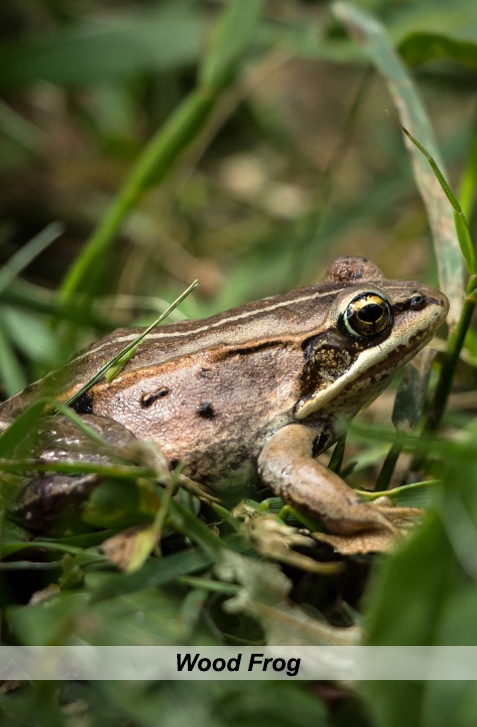
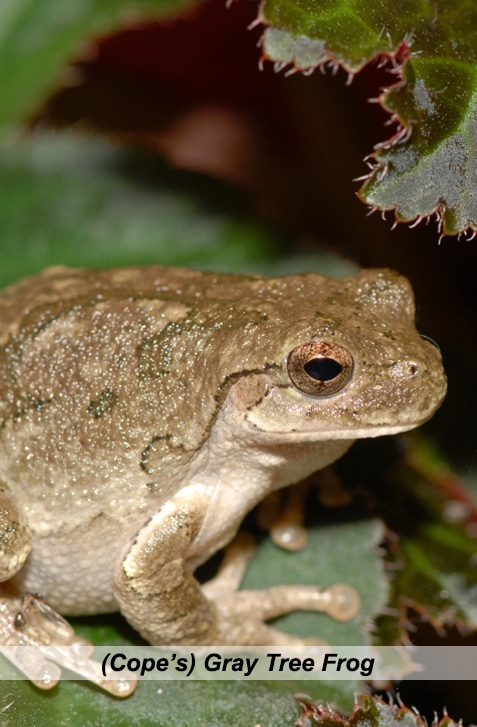
Wood Frog
Rana sylvatica | 1½ to 2¾ inches long
The Wood Frog is normally dark brown or tan, although there have been sightings of red and pink individuals. There are usually no marks on the back but occasionally there are black spots.
- Habitat: Deep, moist soil found in woodlands
- Distribution and status: Found throughout eastern, southern and northwestern Ohio, with occasional instances in western Ohio. Abundant in much of southern and eastern Ohio.
Gray Treefrog and Cope’s Gray Treefrog
Hyla chrysoscelis and Hyla versicolor | 1¼ to 2 inches long
The Gray Treefrog and Cope’s Gray Treefrog are identical in appearance. They differ genetically as the Cope’s Gray Treefrog has twice the number of chromosomes than the Gray Treefrog.
These frogs are gray, but they can change to green for camouflage purposes. There is an irregular lichen-like pattern on the back and there is a white patch under the eyes.
- Habitat: Forests, particularly swamp forests
- Distribution and status: Gray Treefrogs are widespread across Ohio while Cope’s Gray Treefrogs are only present in the southern third of the state. Both species are common in the regions where they occur.
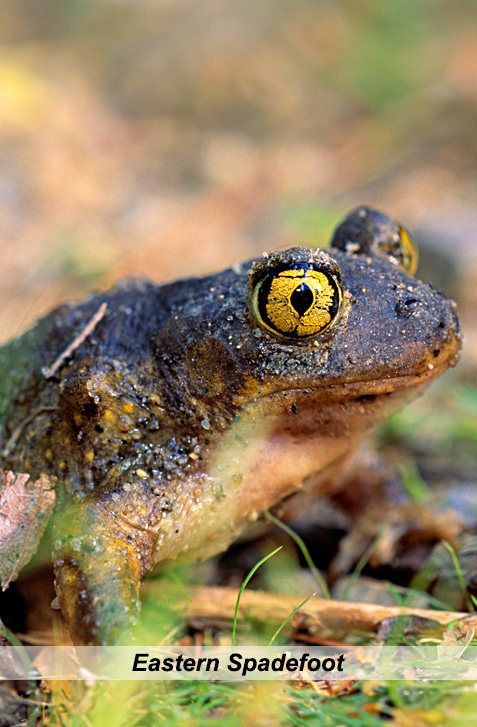

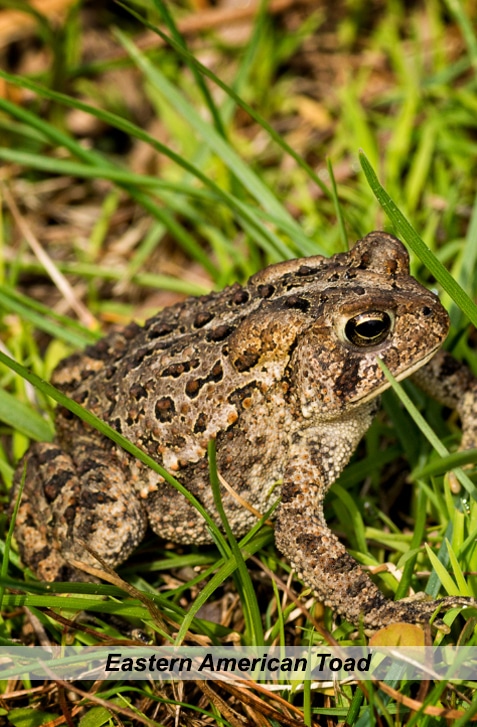
Eastern Spadefoot
Scaphiopus holbrookii | 1¾ to 2¼ inches long
The back of the Eastern Spadefoot is usually brown with two yellow lines forming an hourglass shape. The skin is quite smooth but there are small warts. This is the only Ohio frog species that has vertically elliptical pupils.
- Habitat: Soft, sandy soil in river flood plains
- Distribution and status: Only found in the flood plains of the Ohio, Hocking, Muskingum, and Scioto Rivers, there is a population in Pike County. This is the only frog species that is listed as endangered. There are seven known populations and the only thriving one is in Morgan County. Development is destroying or jeopardizing this species.
Fowler’s Toad
Bufo fowleri | 2 to 3 inches long
The Fowler’s Toad is brown, tan, gray, or light green. Dark spots line the back from behind the eyes. Warts are usually small and grainy.
- Habitat: River and stream valleys with sandy soil
- Distribution and status: Found throughout the state except for a few counties in the northeast. Locally common, with more distribution in the southwest and the southern region of Ohio.
Eastern American Toad
Bufo americanus | 2 to 3½ inches long
The American Toad has dry, warty skin that varies from reddish to gray or tan with dark spots. Warts on the hind legs are large and pointed.
- Habitat: Habitats include fields, woodland, agricultural, and urban areas
- Distribution and status: Widespread in Ohio. The Eastern American Toad is probably the most abundant frog species in the state.
Spotting Frogs in Ohio
Which frogs or toads have you seen in Ohio? We would love to hear from you! Leave a comment below telling us about your sightings!
We have listed the preferred habitats of these frogs in Ohio, but you may also be able to spot them in other areas!
Some of our favorite places to explore are Hocking Hills & Ohio Nature Reserves, where you can find a ton of wildlife in Ohio including Caterpillars, Turtles, Snakes, Garter Snakes, and more!
Hello! We have done our very best to ensure that the accuracy of events, hours, addresses, etc, are up to date. Please know that information can change due to weather, updated health and safety challenges, etc. If you find incorrect information, please send us an email at [email protected], and we can get it updated.
To be updated and stay connected, subscribe to our newsletter.









So many frogs in Ohio, certainly learned a few things here. I am new to your site, I clicked over from instagram after seeing some of your winery posts and now looking through all of them! Keep up the good work!
Thanks Gregg!